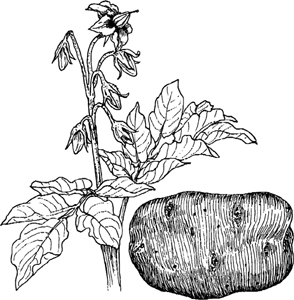
BOTANICAL NAME: Solanum tuberosum
FAMILY: Solanaceae

Many heirloom potatoes were created by regular folks in backyard gardens, and their homey appeal never seems to wane. I can think of Purple Cow Horn, a wonderful baking potato which came out of a New Hampshire garden about 1905, and such perennially popular multicolored varieties as Candy Stripe, a sport or mutant that David Ronninger of Moyie Springs, Idaho, discovered in a patch of Red LaSodas in 1983. My all-time favorite, however, is All-Red, also known as Cranberry Red.
This is a really big midseason potato, with tall robust plants about eighteen to twenty-two inches high, big dark green leaves resembling those of the famous Brandywine tomato, and what must be one of the largest and handsomest lilac purple flowers found on any potato. It is tempting to grow it just for the flowers, except that the plant needs lots of space, and the best part comes when it dies. Underneath the ground is a veritable cache of huge red tubers, some weighing more than half a pound. What makes All-Red so special is its color, inside and out.
The genes that control color in potatoes also have an unhappy side effect: dark skins or dark flesh are sometimes so bitter from traces of glycoalkaloids that the potato is truly unpleasant to eat. This is especially true of wild potatoes, which use these toxins as protection against wild animals that might eat them. Developing a bitterless red potato, one that is red-fleshed, has been one of those much discussed goals of potato enthusiasts for quite a while. Granted, for a long time Americans only wanted white potatoes, but interest in exotic vegetables and potatoes of many colors has put the discussion of an all-red sort out in front.
It took a lot of careful selecting to find a potato that would hold its red color when cooked and not taste bitter. All-Red passed the test and borrowed its name from All-Blue, a somewhat smaller blue-fleshed potato that is commonly seen in upscale markets. All-Blue was developed as a “marker” potato, which growers planted in potato fields to show where one variety stopped and the other began so that they would not become mixed during digging. All-Red is of a somewhat more noble origin.
All-Red was developed by Robert Lobitz, an avid breeder of plants in Paynesville, Minnesota. In the course of our correspondence, Lobitz explained that his All-Red was a seedling of a popular breeding potato called Bison and that he was the person who gave his creation its original name. After he released it to the public through Seed Savers Exchange in about 1984, the potato was picked up by several seed companies and sold under the name Cranberry Red. Cranberry Red and All-Red are indeed the same potato, although Cranberry Red as a name may have slightly more marketing appeal. The new label might seem entirely appropriate since the skin of the potato is a rich cranberry and, like the French potato Roseval, rather startling in intensity when it first comes out of the ground. Raw, the flesh of All-Red is a powder pink. When steamed, it deepens to a pale beet rose, which looks terrific in potato salads. The flavor is rich, like English walnuts, and fulsome, even a bit earthy. Walnut oil in the salad dressing is a perfect match and a good way to enhance the flavor.
Another nice way to cook All-Red is to cut up the potatoes into thin slices. Sauté some chopped onions with olive oil or butter in a large skillet or sauté pan and when they are soft, add the potatoes. When the potatoes begin to brown, add some chicken stock or well-flavored vegetable stock, white wine, chopped green onions, and minced rosemary. Cover and cook for about ten minutes or until the potatoes are tender, then add salt and pepper and serve with grated cheese sprinkled over the top. Your guests will salute you!
All-Red itself is a culinary salute to the determination of growers like Robert Lobitz who create wonderful new things for the common good without remuneration. In a world where all things seem measured in terms of money, All-Red remains a testimony to a higher opposing value. What Robert Lobitz did not know when he sent his creation out into the world is that his potato is also one of the most drought-resistant varieties around. It has been known to yield an embarrassment of riches even when it does not rain for two months. Farmers who lost everything in hybrid soybeans might want to look more carefully into potatoes like All-Red, and home gardeners who appreciate excellent food will not want to be without it. I still wish Robert had called it something more poetic like Minnehaha or Chippewa Rose. No matter, it’s the taste that counts.